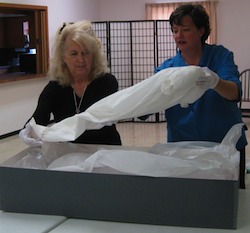
We all have treasures at home, and handling them with special care allows us to preserve these objects for future generations. Careful handling will reduce the risk of physical damage.
Correct handling practices will reduce the risk of physical damage, and assure better preservation of your treasures. Damage such as tears, creases, abrasion, scratches, breakage, and losses is often caused by incorrect handling. Good handling practices are largely based on common sense—being careful, deliberate, and not in a hurry.
Here are a few other points to keep in mind when handling objects:
- Make sure that your hands are clean
- Be certain you have enough space on which to place the object
- Do not eat or drink (or set liquids nearby) while handling your valuable objects
- When a structure is weak, such as a broken photograph, support it overall with rigid material such as a piece of acid-free cardboard
Caring for Your Special Books
- Shelve upright
- Store large volumes flat
- Don’t pull on the headcap (top of the spine) of a book to remove it from the shelf
- Support books with both hands when removing them from shelves and when carrying them
- Store in acid-free, lignin-free cardboard boxes or wrap in acid-free, lignin-free paper and tie with a cotton ribbon
- Don’t press the pages of a book down to provide a flat opening if there is resistance in the spine (this will break the paper and/or the binding)
Caring for Your Documents
- Fold and unfold documents as little as possible (store flat whenever possible)
- House newspapers and other highly acidic documents separately from other items
- Don’t laminate paper materials using heat or adhesive fusion processes; encapsulate instead using Mylar sleeves or jackets
- House in acid-free, lignin-free paper folders and boxes; don’t attempt to flatten objects
- Consider making copies of printed materials for display
Caring for Your Special Objects
If you choose to display items, follow these general guidelines:
Fading and color changes are the most common form of light damage. It is important to recognize that damage may occur gradually over many years and may be difficult to notice initially. Damage caused by light cannot be reversed; it can only be prevented. Particularly valuable objects should only be exhibited for short periods of time (3–4 months) at low light levels. Avoid permanent display of your objects, especially photographs and colored prints.
Direct sunlight and high light levels must also be avoided. Keep lighting fixtures away from your objects because they may also produce damaging heat. Dimly lit interior hallways and staircases are often good locations in a home for display. One approach for showing your treasures is to rotate their display when your family is decorating during holidays or on other special family occasions. While professional framing with good quality materials can be expensive, in the long run it is money well spent.
Resources
- Jane Long and Richard Long. Caring for Your Family Treasures. New York: Harry N. Abrams, Inc., 2000.
- Arthur W. Schultz. Caring for Your Collections. New York: Harry N. Abrams, Inc., 1992.
